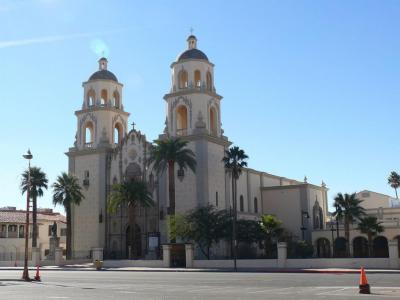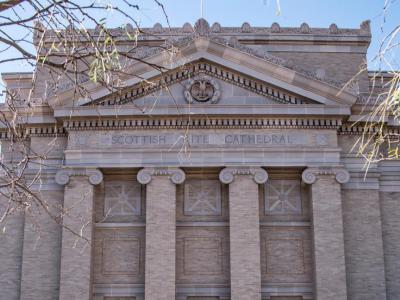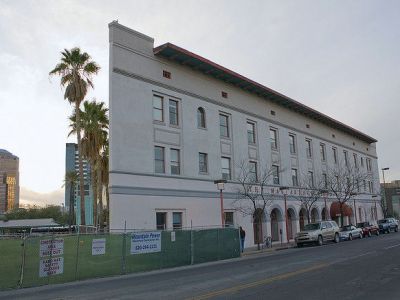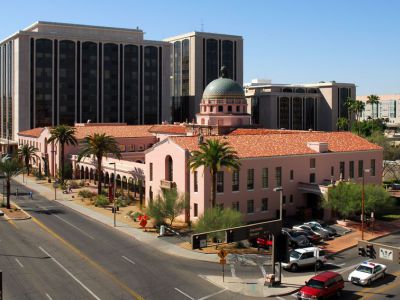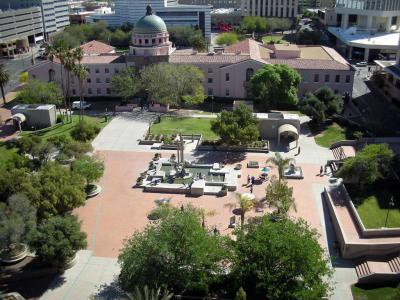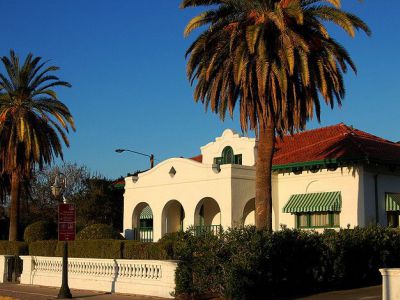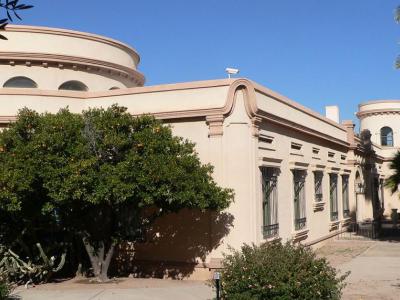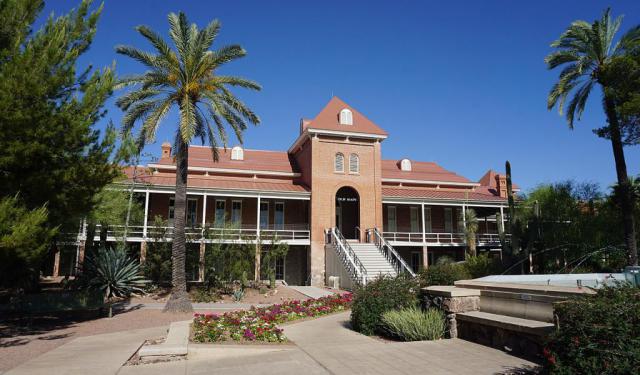Tucson Architecture Walking Tour (Self Guided), Tucson
Just as any city is not an accident but the result of coherent visions and aims, Tucson's architectural landscape bears witness to the city's profound historical narrative and cultural melange.
From the majestic belfries of the Saint Augustine Cathedral, adorned with the Spanish Colonial Revival-style opulence, to the resplendent Scottish Rite Cathedral (also known as the Masonic Temple), an exemplar of Beaux-Arts mastery, the architectural tapestry of Tucson is a mesmerizing portrait of grandeur and sophistication.
Emanating an aura of timeless elegance, the MacArthur Building embodies the spirit of the Art Deco movement, with its sleek contours and geometric allure. Meanwhile, the Pima County Courthouse, an architectural gem of regal proportions, exudes the grandiosity of the Mission Revival style, featuring a picturesque enclosed courtyard, massive adobe walls, broad plaster surfaces, and graceful arcades.
Just behind the Courthouse, within the atmospheric grounds of El Presidio Park, the vestiges of Tucson's Spanish Colonial past evoke an ambiance of heritage and reverence for the city's eventful history.
As the sun bathes the city in its warm embrace, the Corbett House, another resplendent embodiment of the Mission Revival style, enchants onlookers with its vibrant color palette.
Lastly, the Levi H Manning House, an impressive example of territorial-style architecture, features a beguiling blend of Spanish Colonial Revival, Italian Renaissance, and Santa Fe Territorial influences.
In Tucson's architectural realm, artistry meets functionality, and historical significance intertwines with aesthetic splendor. The presented here landmark buildings showcase a colorful blend of design styles and capture the essence of the Southwest's architectural heritage. If you wish to appreciate them up close and personally, take this self-guided walk.
From the majestic belfries of the Saint Augustine Cathedral, adorned with the Spanish Colonial Revival-style opulence, to the resplendent Scottish Rite Cathedral (also known as the Masonic Temple), an exemplar of Beaux-Arts mastery, the architectural tapestry of Tucson is a mesmerizing portrait of grandeur and sophistication.
Emanating an aura of timeless elegance, the MacArthur Building embodies the spirit of the Art Deco movement, with its sleek contours and geometric allure. Meanwhile, the Pima County Courthouse, an architectural gem of regal proportions, exudes the grandiosity of the Mission Revival style, featuring a picturesque enclosed courtyard, massive adobe walls, broad plaster surfaces, and graceful arcades.
Just behind the Courthouse, within the atmospheric grounds of El Presidio Park, the vestiges of Tucson's Spanish Colonial past evoke an ambiance of heritage and reverence for the city's eventful history.
As the sun bathes the city in its warm embrace, the Corbett House, another resplendent embodiment of the Mission Revival style, enchants onlookers with its vibrant color palette.
Lastly, the Levi H Manning House, an impressive example of territorial-style architecture, features a beguiling blend of Spanish Colonial Revival, Italian Renaissance, and Santa Fe Territorial influences.
In Tucson's architectural realm, artistry meets functionality, and historical significance intertwines with aesthetic splendor. The presented here landmark buildings showcase a colorful blend of design styles and capture the essence of the Southwest's architectural heritage. If you wish to appreciate them up close and personally, take this self-guided walk.
How it works: Download the app "GPSmyCity: Walks in 1K+ Cities" from Apple App Store or Google Play Store to your mobile phone or tablet. The app turns your mobile device into a personal tour guide and its built-in GPS navigation functions guide you from one tour stop to next. The app works offline, so no data plan is needed when traveling abroad.
Tucson Architecture Walking Tour Map
Guide Name: Tucson Architecture Walking Tour
Guide Location: USA » Tucson (See other walking tours in Tucson)
Guide Type: Self-guided Walking Tour (Sightseeing)
# of Attractions: 7
Tour Duration: 1 Hour(s)
Travel Distance: 2.1 Km or 1.3 Miles
Author: DanaOffice
Sight(s) Featured in This Guide:
Guide Location: USA » Tucson (See other walking tours in Tucson)
Guide Type: Self-guided Walking Tour (Sightseeing)
# of Attractions: 7
Tour Duration: 1 Hour(s)
Travel Distance: 2.1 Km or 1.3 Miles
Author: DanaOffice
Sight(s) Featured in This Guide:
- Saint Augustine Cathedral
- Scottish Rite Cathedral
- MacArthur Building
- Pima County Courthouse
- El Presidio Park
- Corbett House
- Levi H. Manning House
1) Saint Augustine Cathedral (must see)
The Cathedral of Saint Augustine is one of Tucson’s oldest active religious sites, with origins that trace back to a small chapel founded here in 1776 during the Spanish colonial period. A larger church, completed in 1868, served the expanding Catholic population that settled in the region throughout the 19th century.
The cathedral you see today blends old and new elements. Its 1897 Mexican Baroque façade was preserved during a major reconstruction completed in 1968, when most of the building behind it was rebuilt to improve stability and usability. The result is a structure that retains its historic front while reflecting mid-20th-century updates to the interior layout.
If you stand directly in front of the main entrance and look up, you will see the coat of arms of Pope Pius XI positioned above the central doorway. From this spot, you can also take in the façade’s twin towers, sculpted niches, and carved ornamentation. These features intentionally echo the architectural style of Mission San Xavier del Bac, linking the cathedral to earlier mission traditions in the region. As you walk slowly along the exterior walls, look for the stained-glass windows and stone trim that show the building’s layered construction history.
When you enter the cathedral and step into the nave, look straight ahead toward the sanctuary to find the Pamplona Crucifix. This carved wooden figure, believed through carbon dating to date from the 12th or 13th century, now hangs on the rear sanctuary wall behind the main altar. As you walk further into the space, you will pass side chapels with devotional statues, painted architectural details, and the custom-built pipe organ crafted by Tucson organ maker David McDowell.
Today, the Cathedral of Saint Augustine serves as the mother church of the Roman Catholic Diocese of Tucson. It hosts regular Masses, community gatherings, and diocesan ceremonies, and visitors are welcome during scheduled services or during posted hours for quiet prayer.
Tip: Interior access is most reliable on weekends, and confessions are typically offered on Wednesdays and Fridays.
The cathedral you see today blends old and new elements. Its 1897 Mexican Baroque façade was preserved during a major reconstruction completed in 1968, when most of the building behind it was rebuilt to improve stability and usability. The result is a structure that retains its historic front while reflecting mid-20th-century updates to the interior layout.
If you stand directly in front of the main entrance and look up, you will see the coat of arms of Pope Pius XI positioned above the central doorway. From this spot, you can also take in the façade’s twin towers, sculpted niches, and carved ornamentation. These features intentionally echo the architectural style of Mission San Xavier del Bac, linking the cathedral to earlier mission traditions in the region. As you walk slowly along the exterior walls, look for the stained-glass windows and stone trim that show the building’s layered construction history.
When you enter the cathedral and step into the nave, look straight ahead toward the sanctuary to find the Pamplona Crucifix. This carved wooden figure, believed through carbon dating to date from the 12th or 13th century, now hangs on the rear sanctuary wall behind the main altar. As you walk further into the space, you will pass side chapels with devotional statues, painted architectural details, and the custom-built pipe organ crafted by Tucson organ maker David McDowell.
Today, the Cathedral of Saint Augustine serves as the mother church of the Roman Catholic Diocese of Tucson. It hosts regular Masses, community gatherings, and diocesan ceremonies, and visitors are welcome during scheduled services or during posted hours for quiet prayer.
Tip: Interior access is most reliable on weekends, and confessions are typically offered on Wednesdays and Fridays.
2) Scottish Rite Cathedral
The Scottish Rite Cathedral is a historical building located in downtown Tucson, Arizona. The building is one of the most notable landmarks in the city, and is an important part of Tucson's cultural and architectural history. The Scottish Rite Cathedral was designed by noted architect Henry C. Trost and was completed in 1915. The building's distinctive design features a blend of Gothic and Renaissance Revival styles, with a stunning exterior adorned with intricate stonework and ornate carvings.
Today, the Scottish Rite Cathedral serves as a cultural and community center, hosting a wide range of events and performances throughout the year. The building's large auditorium is a popular venue for concerts, theatrical productions, and other performances, and its elegant ballroom is a popular spot for weddings and other special events. In addition, the Scottish Rite Cathedral is home to several historic artifacts, including the Valley of Tucson Scottish Rite Masonic Museum and Library, which contains a fascinating collection of Masonic regalia, documents, and other historic items.
The Scottish Rite Cathedral is open to the public for tours and events, and is a popular destination for history buffs, architecture enthusiasts, and anyone interested in Tucson's rich cultural heritage.
Today, the Scottish Rite Cathedral serves as a cultural and community center, hosting a wide range of events and performances throughout the year. The building's large auditorium is a popular venue for concerts, theatrical productions, and other performances, and its elegant ballroom is a popular spot for weddings and other special events. In addition, the Scottish Rite Cathedral is home to several historic artifacts, including the Valley of Tucson Scottish Rite Masonic Museum and Library, which contains a fascinating collection of Masonic regalia, documents, and other historic items.
The Scottish Rite Cathedral is open to the public for tours and events, and is a popular destination for history buffs, architecture enthusiasts, and anyone interested in Tucson's rich cultural heritage.
3) MacArthur Building
MacArthur Building is a triangular-shaped building in the city of Tucson. It was built in 1907-1908, was originally known as the Heidel Hotel and d was remodeled into the MacArthur Hotel in 1944. The hotel included a restaurant, saloon and barbershop and was built to serve passengers arriving via the Southern Pacific Railroad Depot. The hotel closed in 1979 and was renovated for office use in 1985.
The design of the structure is peculiar, as it can look like a flat building, depending on the angle. The architects of MacArthur Building were Holmes and Holmes. The building has been the city's landmark for over 100 years. It has been listed on the National Register of Historic Places.
The design of the structure is peculiar, as it can look like a flat building, depending on the angle. The architects of MacArthur Building were Holmes and Holmes. The building has been the city's landmark for over 100 years. It has been listed on the National Register of Historic Places.
4) Pima County Courthouse
The Pima County Courthouse is a historic building that once served as the main courthouse in the region. From its completion in 1929 through 1978 it was home to the Pima County Superior Court. After that point, and through early 2015, the courthouse was home to the Pima County Consolidated Justice Court.
Today, tourists can visit the Pima County Courthouse to see its Mission Revival and Spanish Colonial architectural details. The building recently underwent renovations that restored its original adobe color. Previously, the building was known for the pink paint, which was applied in the early 1950s.
The courthouse isn’t just notable on the outside. Visitors can enjoy the interior of the building while they visit the offices of the Southern Arizona Heritage and Visitor Center, which are open daily.
The Pima County Courthouse is on the National Register of Historic Places. One of the most well-known outlaws held in this building was gangster John Dillinger. Dillinger and his gang were caught in Tucson in 1934. Visitors can still learn about his capture and arraignment during their visit to the courthouse complex.
Dillinger wasn’t the only recognizable figure associated with the Pima County Courthouse. Stories involving actor Clark Gable and later actor Johnny Depp have become part of local lore, though details of these accounts remain unverified.
The building has also been used for films, including the 1976 version of A Star Is Born and the 1980 comedy Stir Crazy.
Today, tourists can visit the Pima County Courthouse to see its Mission Revival and Spanish Colonial architectural details. The building recently underwent renovations that restored its original adobe color. Previously, the building was known for the pink paint, which was applied in the early 1950s.
The courthouse isn’t just notable on the outside. Visitors can enjoy the interior of the building while they visit the offices of the Southern Arizona Heritage and Visitor Center, which are open daily.
The Pima County Courthouse is on the National Register of Historic Places. One of the most well-known outlaws held in this building was gangster John Dillinger. Dillinger and his gang were caught in Tucson in 1934. Visitors can still learn about his capture and arraignment during their visit to the courthouse complex.
Dillinger wasn’t the only recognizable figure associated with the Pima County Courthouse. Stories involving actor Clark Gable and later actor Johnny Depp have become part of local lore, though details of these accounts remain unverified.
The building has also been used for films, including the 1976 version of A Star Is Born and the 1980 comedy Stir Crazy.
5) El Presidio Park
Between the Old County Courthouse and City Hall lies El Presidio Park. What looks like a simple park actually has a very long and storied history.
The land was first used as the military plaza and fort grounds for the Presidio San Agustín del Tucson. It also served as a gathering place for the Spanish and American settlers. In the 1860s, the nearby district became known as a “free zone,” or Barrio Libre, a name tied to its independent character. It wasn’t until the 1970s that the area took on its modern role as a park once more.
Today, El Presidio Park is nearly three acres of green space, a rose garden, veterans memorials and art installations. It is not uncommon to see festivals taking place in the park, including the Tucson Folk Festival and the Tucson Meet Yourself Festival. It is also a popular spot for political rallies, celebrations and weddings.
Tourists should stop at each of the memorial statues to develop an understanding of the changes that took place over the years. They can also see an original marker of the walls of the old Presidio.
The land was first used as the military plaza and fort grounds for the Presidio San Agustín del Tucson. It also served as a gathering place for the Spanish and American settlers. In the 1860s, the nearby district became known as a “free zone,” or Barrio Libre, a name tied to its independent character. It wasn’t until the 1970s that the area took on its modern role as a park once more.
Today, El Presidio Park is nearly three acres of green space, a rose garden, veterans memorials and art installations. It is not uncommon to see festivals taking place in the park, including the Tucson Folk Festival and the Tucson Meet Yourself Festival. It is also a popular spot for political rallies, celebrations and weddings.
Tourists should stop at each of the memorial statues to develop an understanding of the changes that took place over the years. They can also see an original marker of the walls of the old Presidio.
6) Corbett House
The Corbett House is a popular stop for visitors interested in local arts and architecture. This Mission Revival–style home was completed in 1907 and served as the residence of the J. Knox Corbett family until 1963.
The Corbetts were a well-known Tucson family, and their home often functioned as a gathering place for community events and social occasions. Inside, the family furnished the rooms with European art and carefully chosen pieces that reflected both taste and status. The house also contained one of the area’s earliest air-conditioning systems, a notable feature at the time. Local stories even suggest that a small gin still operated here during Prohibition, adding another layer of interest to the property’s history.
J. Knox Corbett served as mayor, and his wife, Lizzie Hughes Corbett, was the daughter of Samuel C. Hughes, a Tucson City Council member and an influential figure in the city’s early development. Their home reflects the connections and ambitions of some of Tucson’s most active early residents.
Today, visitors can tour the Corbett House on Sundays through guided visits that highlight the home’s architectural details, original furnishings, and family history. While it is not open for general drop-in visits, those who plan ahead can step inside one of Tucson’s most notable historic homes and get a closer look at the life of a prominent early-20th-century family.
The Corbetts were a well-known Tucson family, and their home often functioned as a gathering place for community events and social occasions. Inside, the family furnished the rooms with European art and carefully chosen pieces that reflected both taste and status. The house also contained one of the area’s earliest air-conditioning systems, a notable feature at the time. Local stories even suggest that a small gin still operated here during Prohibition, adding another layer of interest to the property’s history.
J. Knox Corbett served as mayor, and his wife, Lizzie Hughes Corbett, was the daughter of Samuel C. Hughes, a Tucson City Council member and an influential figure in the city’s early development. Their home reflects the connections and ambitions of some of Tucson’s most active early residents.
Today, visitors can tour the Corbett House on Sundays through guided visits that highlight the home’s architectural details, original furnishings, and family history. While it is not open for general drop-in visits, those who plan ahead can step inside one of Tucson’s most notable historic homes and get a closer look at the life of a prominent early-20th-century family.
7) Levi H. Manning House
The Levi H. Manning House was built during the turn of the 20th century. The home was created in an area called Snob Hollow and was originally a 12,000 square foot mansion. Since that time, it has been expanded into a 30,000 square foot space that functioned as an events center. Today it is a popular spot for visitors on walking tours of the city.
Levi H. Manning was mayor of Tucson. He built his fortune in mining, but was also active in the early days of electricity. He is credited with using an electric trolley system in the town to replace the horse and buggy.
The home is not currently in use or open to the public, but it has been used as a headquarters for the Elks Lodge and as a special events venue. Those on walking tours will marvel at the unique combination of Spanish Colonial, Italian Renaissance and Santa Fe Territorial architecture. Visitors can also spot frescoes featuring motifs of exotic birds and flowers that were painted by the artist Salvador Corona.
Some tourists may go on a ghost hunt at the Levi H. Manning House. Its reputation as a haunted house has endured for decades. Visitors have claimed to see apparitions floating by holding candlesticks before disappearing once again.
Levi H. Manning was mayor of Tucson. He built his fortune in mining, but was also active in the early days of electricity. He is credited with using an electric trolley system in the town to replace the horse and buggy.
The home is not currently in use or open to the public, but it has been used as a headquarters for the Elks Lodge and as a special events venue. Those on walking tours will marvel at the unique combination of Spanish Colonial, Italian Renaissance and Santa Fe Territorial architecture. Visitors can also spot frescoes featuring motifs of exotic birds and flowers that were painted by the artist Salvador Corona.
Some tourists may go on a ghost hunt at the Levi H. Manning House. Its reputation as a haunted house has endured for decades. Visitors have claimed to see apparitions floating by holding candlesticks before disappearing once again.
Walking Tours in Tucson, Arizona
Create Your Own Walk in Tucson
Creating your own self-guided walk in Tucson is easy and fun. Choose the city attractions that you want to see and a walk route map will be created just for you. You can even set your hotel as the start point of the walk.
Tucson Downtown Walking Tour
Tucson is a city shaped by layered stories and memorable characters. Italian geographer and explorer Eusebio Kino passed through this desert valley in the late 1600s, laying early foundations for future settlements, and centuries later the legendary Earp brothers arrived in town during a turbulent chapter of frontier history. Their time in Tucson was brief, but it reflects something true about the... view more
Tour Duration: 2 Hour(s)
Travel Distance: 3.0 Km or 1.9 Miles
Tour Duration: 2 Hour(s)
Travel Distance: 3.0 Km or 1.9 Miles
University of Arizona Walking Tour
Founded in 1885, the University of Arizona (U of A) was the first university in the state, and so far has been the only representative from the state of Arizona in the Association of American Universities.
The U of A campus in Tucson proudly showcases a number of landmarks, each with its own story and unique allure. Among these, the Old Main building, an architectural gem, completed in 1891,... view more
Tour Duration: 2 Hour(s)
Travel Distance: 2.8 Km or 1.7 Miles
The U of A campus in Tucson proudly showcases a number of landmarks, each with its own story and unique allure. Among these, the Old Main building, an architectural gem, completed in 1891,... view more
Tour Duration: 2 Hour(s)
Travel Distance: 2.8 Km or 1.7 Miles
The Most Popular Cities
/ view all



